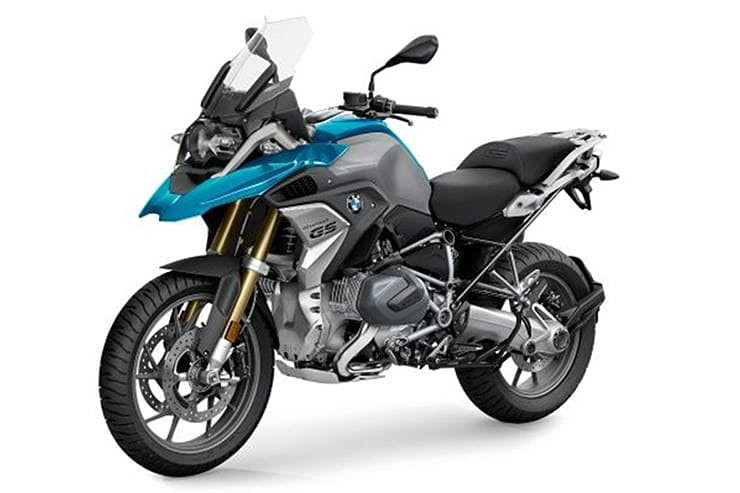Motorcycling can seem complex, especially when you’re new to the scene. Decades ago, things were simpler: road bikes looked like classic motorcycles, off-road versions had knobbly tires, learner bikes were smaller, and sidecar outfits were for families. Today, the variety is much broader.
If you’re just getting into the exciting world of motorbikes – welcome! – this guide explains the main categories to help you understand the different Kinds Of Motor Bikes available.
 BMW R1250GS Adventure Bike: showcasing the typical tall stance and rugged look of adventure motorcycles.
BMW R1250GS Adventure Bike: showcasing the typical tall stance and rugged look of adventure motorcycles.
1. Adventure Bikes
Adventure bikes are styled to evoke images of globetrotting expeditions, like a two-wheeled equivalent of a Range Rover ready for Kathmandu. Interestingly, while they look rugged and off-road capable, they excel as comfortable road bikes. Their weight can make them challenging on actual off-road terrain, leading many owners to stick to paved roads. However, riders appreciate their comfortable, upright riding position, excellent protection from the elements, and smooth suspension on tarmac. Adventure motorcycles often feature tall designs and larger engines, exemplified by the popular BMW R1250GS with its 1254cc engine. However, more accessible, smaller versions like the Suzuki V-Strom 250 are also available, making the adventure bike category diverse.
Perfect Example: BMW R1250GS
Tell-tale Signs: High seat height, distinctive beak-like front fairing, riders often in textile riding gear.
2. Cruiser Bikes
Picture a Harley-Davidson, and you’ve essentially visualized a cruiser. These motorbikes are characterized by their long, low stance and relaxed V-twin engines – engines with two cylinders forming a V-shape. While a cruiser can accelerate surprisingly quickly from a standstill, often outperforming sports cars, outright speed isn’t their primary focus. Instead, cruisers are designed for a cool, laid-back riding experience, ideal for leisurely cruising. Harley-Davidson dominates this category, but numerous other manufacturers offer their own variations of cruiser motorcycles within their lineups, appealing to riders who value style and relaxed performance.
Perfect Example: Harley Fat Boy
Tell-tale Signs: Low seat height, extensive chrome detailing, riders often wearing open-face helmets.
3. Naked Bikes
Naked bikes are the modern descendants of traditional motorcycles, reminiscent of the bikes your grandfather might have ridden. They forgo elaborate fairings, presenting a straightforward design with just two wheels and an engine prominently displayed. Offering a relatively upright riding posture, they are comfortable for everyday use yet designed to be agile and responsive, distinguishing them from cruisers. Naked motorcycles are enjoyable for navigating twisty roads and offer a direct, engaging riding experience. While some are incredibly fast, essentially being sportbikes without fairings, most serve as excellent motorcycles for beginners and intermediate riders. The absence of fairings also contributes to a more affordable price point, making them an attractive option for many.
Perfect Example: Yamaha MT-07
Tell-tale Signs: Absence of fairing, visible engine components, riders often wearing casual jackets and jeans.
4. Sportsbikes
Sportsbikes are frequently called race replicas, and for good reason: they are street-legal versions of racing motorcycles, complete with full fairings for aerodynamic efficiency, firm suspension systems, and high-performance, finely tuned engines. The advantage of these features is exceptional performance in ideal conditions, making them the fastest motorcycles on a racetrack. However, the trade-off is a demanding riding position that places significant pressure on the wrists and can strain the legs, making them less suitable for long journeys or everyday commuting. Despite this, most major manufacturers include a sportsbike as a flagship model in their range, and there are also smaller, more beginner-friendly versions available, allowing riders to experience the thrill of sports motorcycles at various skill levels.
Perfect Example: Honda CBR1000RR-R Fireblade
Tell-tale Signs: Full fairing, model names often include numerous “R” designations, riders typically wearing full racing leathers.
5. Tourer Bikes
Large, luxurious, and equipped with ample luggage capacity, tourer bikes are designed for covering long distances, especially when traveling with a passenger. While many types of motorcycles can be used for touring, a dedicated tourer makes long-distance riding exceptionally comfortable and effortless. A well-designed tourer allows for cruising at high speeds for extended periods without strain – unlike cruisers, which are more comfortable at lower speeds. Touring motorcycles often come equipped with advanced features such as audio systems, heated seats, and integrated luggage locking mechanisms. As expected with their extensive features and capabilities, they tend to be among the more expensive kinds of motor bikes available.
Perfect Example: BMW R1250RT
Tell-tale Signs: Extensive fairing for wind protection, substantial built-in luggage systems, riders and passengers often equipped with intercom systems.
6. Sports Tourer Bikes
Sports tourers represent a hybrid, combining the agility of a sportsbike with the comfort and touring capabilities of a tourer. Lighter and more maneuverable than dedicated tourers, yet significantly more comfortable for long distances than sportsbikes, they offer a balanced compromise. Sports touring motorcycles were once very popular, providing a versatile option for riders. However, the rise of adventure bikes, which offer even greater comfort and only slightly less cornering performance while projecting a more adventurous image, has somewhat diminished the sports tourer’s popularity in recent years. Despite this shift, they remain a solid choice for riders seeking a blend of sport and touring functionalities.
Perfect Example: Kawasaki Ninja 1000SX
Tell-tale Signs: Fairing, sporty styling cues, riders often wearing black leather or sporty textile gear.
7. Dual Sport Bikes
If you need a motorcycle that can handle your daily commute during the week and tackle off-road trails on weekends, a dual sport bike (also known as dual purpose) is an ideal choice. These are street-legal motorcycles that are also highly capable off-road. Unlike adventure bikes, which are often road bikes styled for off-road looks, dual sports are fundamentally off-road bikes adapted for street use. This means they are lightweight – often half the weight of a large adventure bike – equipped with tires that grip well in mud, and feature large, impact-absorbing front wheels. The trade-off for their off-road prowess is that they may lack some road-oriented features. They can be less comfortable and slower for long highway journeys, and their knobbly tires can be less stable on paved corners, especially in wet conditions.
Perfect Example: Honda CRF450L
Tell-tale Signs: No fairing, often showing signs of mud, riders often wearing off-road goggles.
8. Classic Bikes
A classic bike is simply an older motorcycle. Defining exactly how old is “old” is subjective, but most riders consider any motorcycle manufactured before 1980 to be definitively classic. As you go further back in time, more specific categories emerge. For instance, a veteran motorcycle is one made before 1915, and a vintage bike is generally pre-1975, according to the Vintage Motorcycle Club (though American definitions may vary slightly). Motorcycles made between 1980 and 1995 can be considered modern classics, depending on their reputation and desirability. A highly regarded model like the 1992 Honda Fireblade is undoubtedly a modern classic, whereas a Suzuki GS500 from the same era might not be viewed in the same way.
Perfect Example: 1969 Triumph Bonneville T120
Tell-tale Signs: No fairing, abundant chrome accents, riders humorously depicted as carrying spanners (wrenches).
9. Off-Road Bikes
Off-road bikes are purpose-built for off-road riding, with no compromises for street legality. They are lightweight, offer rapid acceleration, feature advanced suspension systems designed for rough terrain, and are fitted with knobbly tires for maximum grip on loose surfaces. Most are competition-oriented, designed for motocross racing (short, obstacle-filled tracks), enduro racing (longer courses with natural obstacles), or trials (navigating obstacles without putting feet down). Some are purchased for recreational off-road riding, although their lack of street legality restricts where they can be used. These kinds of motor bikes are purely for off-road enjoyment and competition.
Perfect Example: KTM 450 SX-F
Tell-tale Signs: No fairing, very high seat height, riders often wearing brightly colored, pajama-like riding gear.
10. Scooter Bikes
Finally, an easy category: scooters have maintained a fairly consistent design since the original Vespa in 1947. If it has small wheels, a floorboard to rest your feet, and an automatic transmission, it’s a scooter. Scooters are excellent for urban transport, providing good weather protection, ample under-seat storage, and the convenience of automatic operation – simply twist the throttle and go. Many manufacturers also offer larger “maxi-scooters” capable of higher speeds and suitable for highway travel, extending the usability of scooter bikes beyond city limits.
Perfect Example: Honda PCX125
Tell-tale Signs: Small diameter wheels, step-through footboards, riders often dressed in everyday attire like shirt sleeves.
11. Moped Bikes
Technically, a moped is defined as a motorcycle with pedals, but today the term generally refers to any motorcycle with an engine displacement of less than 50cc. In many regions, 16-year-olds can ride mopeds with basic licensing after completing compulsory basic training. Mopeds are typically speed-limited, making them less suitable for long distances, but they are fuel-efficient, ideal for city commuting, and serve as an accessible entry point into motorcycling. They represent the most accessible kinds of motor bikes for younger or new riders.
Perfect Example: Mash Roadstar 50
Tell-tale Signs: Very small (50cc) engine, motorcycle-like appearance, riders often appearing to be holding the throttle fully open.
12. Custom Bikes
When a motorcycle’s appearance has been intentionally and significantly altered (beyond just accident damage), it’s considered customized and is known as a custom bike. Custom motorcycles range from artistic creations displayed in galleries to incredible feats of engineering, and sometimes, less appealing modifications. Distinct custom styles have evolved, each with its own set of characteristics and enthusiasts. Choppers feature extended front forks and no rear suspension, trackers resemble dirt track racers, cafe racers mimic 1950s sportbikes, bobbers are stripped down and minimalist, and streetfighters are often sportbikes with raised handlebars and removed fairings – sometimes resulting from accidents. Custom bikes represent a broad spectrum of motorcycle modification and personalization.
Perfect Example: Harley chopper
Tell-tale Signs: Unique and individualized appearance, often featuring many custom-machined parts, riders often exuding a sense of pride in their unique machine.

